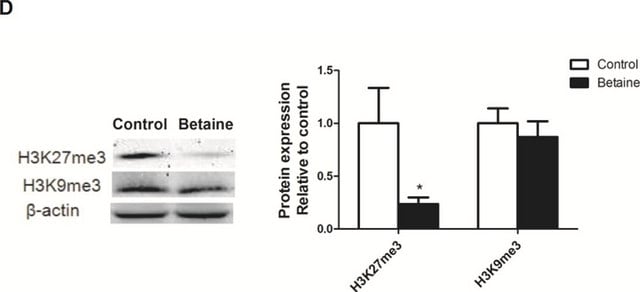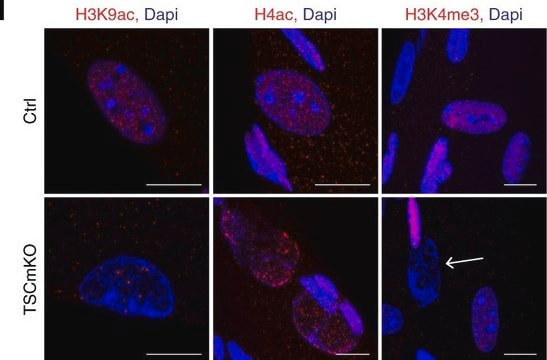17-678
ChIPAb+ Trimethyl-Histone H3 (Lys4) - ChIP Validated Antibody and Primer Set
clone CMA304, from mouse, purified by using protein G
Synonym(s):
H3K4me3, Histone H3 (tri methyl K4)
Sign Into View Organizational & Contract Pricing
All Photos(3)
About This Item
UNSPSC Code:
12352203
eCl@ss:
32160702
NACRES:
NA.32
Recommended Products
biological source
mouse
Quality Level
clone
CMA304, monoclonal
purified by
using protein G
species reactivity
human, vertebrates
manufacturer/tradename
ChIPAb+
Upstate®
technique(s)
ChIP: suitable (ChIP-seq)
immunocytochemistry: suitable
western blot: suitable
isotype
IgG1κ
NCBI accession no.
shipped in
dry ice
General description
All ChIPAb+ antibodies are individually validated for chromatin precipitation, every lot, every time. Each ChIPAb+ antibody set includes control primers (tested every lot by qPCR) to biologically validate your IP results in a locus-specific context. The qPCR protocol and primer sequences are provided, allowing researchers to validate ChIP protocols when using our antibody in their chromatin context. Each set also includes a negative control antibody to ensure specificity of the ChIP reaction.
The ChIPAb+ Trimethyl-Histone H3 (Lys4) set includes the Anti-trimethyl-Histone H3 (Lys4) antibody, a negative control antibody (purified Mouse IgG), and qPCR primers which amplify a 166 bp region within the promoter of the human GAPDH gene. The trimethyl-Histone H3 (Lys4) and negative control antibodies are supplied in a scalable "per ChIP" reaction size and can be used to functionally validate the precipitation of trimethyl-histone H3 (Lys4)-associated chromatin.
The ChIPAb+ Trimethyl-Histone H3 (Lys4) set includes the Anti-trimethyl-Histone H3 (Lys4) antibody, a negative control antibody (purified Mouse IgG), and qPCR primers which amplify a 166 bp region within the promoter of the human GAPDH gene. The trimethyl-Histone H3 (Lys4) and negative control antibodies are supplied in a scalable "per ChIP" reaction size and can be used to functionally validate the precipitation of trimethyl-histone H3 (Lys4)-associated chromatin.
The previously assigned protein identifier Q66I33 has been merged into P84243. Full details can be found on the UniProt database.
Specificity
Recognizes histone H3, Mr 17 kDa, trimethylated at Lys4.
The immunogen sequence is identical in a wide range of animal and plant species.
Immunogen
Epitope: a.a. 1-12
The trimethyl-histone H3 (Lys4) purified antibody is made against a synthetic peptide (trimethylated at Lys4) corresponding to amino acids 1-12 of human histone H3.
Application
Chromatin Immunoprecipitation:
Sonicated chromatin prepared from untreated or colcemid treated HeLa cells (1 X 106 cell equivalents per IP) was subjected to chromatin immunoprecipitation using 2 µg of either a normal mouse IgG or Anti-trimethyl-Histone H3 (Lys4) antibody and the Magna ChIP G Kit (Cat. #17-611). Successful immunoprecipitation of trimethyl-Histone H3 (Lys4) associated DNA fragments was verified by qPCR using primers ampliflying a region of the human B-Globin promoter or using GAPDH promoter Control Primers (Please see figures). Data is presented as percent input of each IP sample relative to input chromatin for each amplicon and ChIP sample as indicated.
Please refer to the EZ-Magna G ChIP (Cat. #17-408) or EZ-ChIP (Cat. #17-371) protocol for experimental details.
Western Blot Analysis:
Representative lot data.
HeLa acid extract were resolved by electrophoresis, transferred to PVDF membrane and probed with Anti-trimethyl Histone H3 (Lys4), clone CMA304 at 1 μg/ml (lane 1) or 0.5 μg/ml (lane 2). Proteins were visualized using a goat anti-mouse secondary antibody conjugated to HRP (Cat. #AP124P) and a chemiluminescence detection system (Please see figures).
Sonicated chromatin prepared from untreated or colcemid treated HeLa cells (1 X 106 cell equivalents per IP) was subjected to chromatin immunoprecipitation using 2 µg of either a normal mouse IgG or Anti-trimethyl-Histone H3 (Lys4) antibody and the Magna ChIP G Kit (Cat. #17-611). Successful immunoprecipitation of trimethyl-Histone H3 (Lys4) associated DNA fragments was verified by qPCR using primers ampliflying a region of the human B-Globin promoter or using GAPDH promoter Control Primers (Please see figures). Data is presented as percent input of each IP sample relative to input chromatin for each amplicon and ChIP sample as indicated.
Please refer to the EZ-Magna G ChIP (Cat. #17-408) or EZ-ChIP (Cat. #17-371) protocol for experimental details.
Western Blot Analysis:
Representative lot data.
HeLa acid extract were resolved by electrophoresis, transferred to PVDF membrane and probed with Anti-trimethyl Histone H3 (Lys4), clone CMA304 at 1 μg/ml (lane 1) or 0.5 μg/ml (lane 2). Proteins were visualized using a goat anti-mouse secondary antibody conjugated to HRP (Cat. #AP124P) and a chemiluminescence detection system (Please see figures).
Research Category
Epigenetics & Nuclear Function
Epigenetics & Nuclear Function
Research Sub Category
Chromatin Biology
Chromatin Biology
This ChIPAb+ Trimethyl-Histone H3 (Lys4) -ChIP Validated Antibody & Primer Set conveniently includes the antibody & the specific control PCR primers.
Packaging
25 assays per kit, ~2μg per chromatin immunoprecipitation
Quality
Chromatin Immunoprecipitation:
Sonicated chromatin prepared from colcemid-reated HeLa cells (1 X 106 cell equivalents per IP) were subjected to chromatin immunoprecipitation using 2 µg of either normal mouse IgG or Anti-trimethyl-Histone H3 (Lys4) antibody and the Magna ChIP G Kit (Cat. #17-611). Successful immuno-precipitation of trimethyl-histone H3 (Lys4) associated DNA fragments was verified by qPCR using Control Primers (Please see figures).
Please refer to the EZ-Magna G ChIP (Cat. #17-409) or EZ-ChIP (Cat. #17-371) protocol for experimental details.
Sonicated chromatin prepared from colcemid-reated HeLa cells (1 X 106 cell equivalents per IP) were subjected to chromatin immunoprecipitation using 2 µg of either normal mouse IgG or Anti-trimethyl-Histone H3 (Lys4) antibody and the Magna ChIP G Kit (Cat. #17-611). Successful immuno-precipitation of trimethyl-histone H3 (Lys4) associated DNA fragments was verified by qPCR using Control Primers (Please see figures).
Please refer to the EZ-Magna G ChIP (Cat. #17-409) or EZ-ChIP (Cat. #17-371) protocol for experimental details.
Target description
Trimethyl histone H3 at ~17 kDa
Physical form
Anti-trimethyl-Histone H3 (Lys4) (mouse monoclonal IgG1, Clone CMA304). One vial containing 50 μg of protein G purified antibody in 50 μL PBS containing 0.05% sodium. Store at -20°C.
Normal Mouse IgG. Two vials containing 25 μg purified mouse IgG in 25 μL storage buffer containing 0.1% sodium azide. Store at -20°C.
Control Primers. One vial containing 75 μL of 5 μM of each primer specific for the promoter region of GAPDH. Store at -20°C.
FOR: TAC TAG CGG TTT TAC GGG CG
REV: TCG AAC AGG AGG AGC AGA GAG CGA
Normal Mouse IgG. Two vials containing 25 μg purified mouse IgG in 25 μL storage buffer containing 0.1% sodium azide. Store at -20°C.
Control Primers. One vial containing 75 μL of 5 μM of each primer specific for the promoter region of GAPDH. Store at -20°C.
FOR: TAC TAG CGG TTT TAC GGG CG
REV: TCG AAC AGG AGG AGC AGA GAG CGA
Storage and Stability
Stable for 1 year at -20°C from date of receipt. Aliquot upon thawing, avoid freeze thaw cycles.
Analysis Note
Control
Included negative control mouse IgG antibody and control primers specific for human GAPDH promoter.
Included negative control mouse IgG antibody and control primers specific for human GAPDH promoter.
Legal Information
UPSTATE is a registered trademark of Merck KGaA, Darmstadt, Germany
Disclaimer
Unless otherwise stated in our catalog or other company documentation accompanying the product(s), our products are intended for research use only and are not to be used for any other purpose, which includes but is not limited to, unauthorized commercial uses, in vitro diagnostic uses, ex vivo or in vivo therapeutic uses or any type of consumption or application to humans or animals.
Storage Class Code
10 - Combustible liquids
Certificates of Analysis (COA)
Search for Certificates of Analysis (COA) by entering the products Lot/Batch Number. Lot and Batch Numbers can be found on a product’s label following the words ‘Lot’ or ‘Batch’.
Already Own This Product?
Find documentation for the products that you have recently purchased in the Document Library.
Jonathan C Irish et al.
Molecular oncology, 10(6), 850-865 (2016-03-24)
The 8p11-p12 amplicon occurs in approximately 15% of breast cancers in aggressive luminal B-type tumors. Previously, we identified WHSC1L1 as a driving oncogene from this region. Here, we demonstrate that over-expression of WHSC1L1 is linked to over-expression of ERα in
Pei Wang et al.
Drug metabolism and disposition: the biological fate of chemicals, 49(5), 361-368 (2021-03-07)
The maintenance of homeostasis of cytochromes P450 enzymes (P450s) under both physiologic and xenobiotic exposure conditions is ensured by the action of positive and negative regulators. In the current study, the hepatocyte nuclear factor 4α (HNF4A) antisense RNA 1 (HNF4A-AS1)
Weiping Wang et al.
Molecular and cellular endocrinology, 428, 38-48 (2016-03-21)
The mechanism of insulin gene transcription control in response to glucose concentration is poorly defined. The islet-restricted transcription factors PDX1 and ISL1 interact with BETA2, activating insulin gene expression. However, their contribution and hierarchical organization in insulin expression control based
The gene signature in CCAAT-enhancer-binding protein ? dysfunctional acute myeloid leukemia predicts responsiveness to histone deacetylase inhibitors.
Liss, A; Ooi, CH; Zjablovskaja, P; Benoukraf, T; Radomska, HS; Ju, C; Wu, M; Balastik et al.
Haematologica null
Judy A Brusslan et al.
Plant physiology, 168(4), 1246-1261 (2015-03-25)
The genome-wide abundance of two histone modifications, H3K4me3 and H3K9ac (both associated with actively expressed genes), was monitored in Arabidopsis (Arabidopsis thaliana) leaves at different time points during developmental senescence along with expression in the form of RNA sequencing data.
Our team of scientists has experience in all areas of research including Life Science, Material Science, Chemical Synthesis, Chromatography, Analytical and many others.
Contact Technical Service








